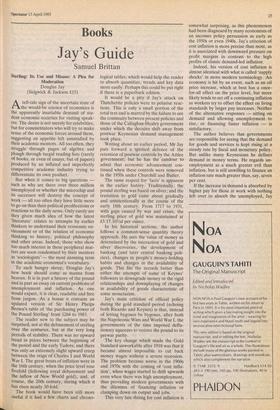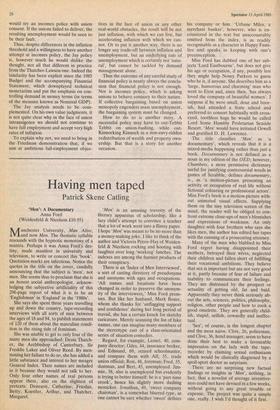Books
Jay's Guide
Samuel Brittan
Sterling: Its Use and Misuse: A Plea for Moderation Douglas Jay (Sidgwick & Jackson £15) Atell-tale sign of the uncertain state of he would-be science of economics is the apparently insatiable demand of stu- dent economic societies for visiting speak- ers. The desire is not merely for celebrities, but for commentators who will try to make sense of the economic forces around them, suggesting an appetite left unsatisfied by their academic mentors. All too often, they struggle through pages of algebra and Plough through turgid reading lists (rarely of books, or even of essays, but of papers) produced by an inflated and imperfectly competitive academic industry trying to differentiate its own product.
But when it comes to big questions — such as why are there over three million unemployed or whether the microchip and its successor will destroy the concept of work — all too often they have little more to go on than their political predilections or reactions to the daily news. Only rarely are they given much idea of how the latest 'literature' relates to attempts by earlier thinkers to understand their economic en- vironment or of the relation of economic thinking to history, political philosophy and other areas. Indeed, those who show too much interest in these peripheral mat- ters are soon condemned by their mentors as 'sociologists' — the most damning term in the academic economist's vocabulary.
To such hungry sheep, Douglas Jay's new book should come as manna from heaven. It is in part a history of the pound and in part an essay on current problems of unemployment and inflation. As one would expect, it is clear, readable and free from jargon. As a bonus it contains an Updated version of Sir Henry Phelps Brown's table of 'the purchasing power of the Pound Sterling' from 1264 to 1983.
The reader new to the subject may be surprised, not at the debasement of sterling over the centuries, but at the very long periods of stability. There was no upward trend in prices between the beginning of the period and the early Tudors; and there was only an extremely slight upward creep between the reign of Charles I and World War I. The great bouts of inflation were in the 16th century, when the price level rose fivefold (following royal debasement and the inflow of New World gold), and, of course, the 20th century, during which it has risen nearly 30-fold.
The book would have been still more useful if it had a few charts and chrono-
logiCal tables, which would help the reader to absorb quantities, trends and key data more easily. Perhaps this could be put right if there is a paperback edition.
It would be a pity if Jay's attack on Thatcherite policies were to polarise reac- tions. This is only a small portion of the total text and is marred by the failure to see the continuity between present policies and those of the Callaghan-Healey government under which the decisive shift away from postwar Keynesian demand management took place.
Writing about an earlier period, Mr Jay puts forward a spirited defence of the retention of postwar controls by the Attlee government; but he has the candour to admit that economic advancement con- tinued when these controls were removed in the 1950s under Churchill and Butler.
The same respect for 'facts' is apparent in the earlier history. Traditionally, the pound sterling was based on silver; and the transition to gold came about gradually and unintentionally in the course of the early 18th century. From 1717 to 1931, with gaps caused by war and crises, the sterling price of gold was maintained at £3.17.101/2d per ounce.
In his historical sections, the author follows a common-sense quantity theory approach. He sees the value of money as determined by the interaction of gold and silver discoveries, the development of banking (and later central banking poli- cies), changes in people's money-holding habits and changes in the availability of goods. This fits the records better than either the attempts of some of Keynes' followers to downgrade money or the rigid relationships and downplaying of changes in availability of goods characteristic of some monetarists.
Jay's main criticism of official policy during the gold standard period (echoing both Ricardo and Keynes) is that, instead of letting bygones be bygones, after both the Napoleonic Wars and World War!, the governments of the time imposed defla- tionary squeezes to restore the pound to its prewar parity.
The key change which made the Gold Standard unworkable after 1918 was that it became almost impossible to cut back money wages without a severe recession.
The problem became worse in the 1960s and 1970s with the coming of 'cost infla-
tion', when wages started to drift upwards even when there was high unemployment, thus providing modern governments with the dilemma of financing inflation or clamping down on output and jobs.
This very late dating for cost inflation is somewhat surprising, as this phenomenon had been diagnosed by many economists of an incomes policy persuasion as early as the 1950s or even 1940s. Jay's criterion of cost inflation is more precise than most, as it is associated with downward pressure on profit margins in contrast to the high profits of classic demand-led inflation'.
Indeed, his version of cost inflation is almost identical with what is called 'supply shocks' in more modern terminology. An economy is hit by an event, such as an oil price increase, which at best has a once- for-all effect on the price level, but more likely tends to set off a continuing inflation as workers try to offset the effect on living standards by larger pay increases. Neither of the alternative responses — sitting on demand and allowing unemployment to rise, or financing faster inflation — is satisfactory.
The author believes that governments are responsible for seeing that the demand for goods and services is kept rising at a steady rate by fiscal and monetary policy. But unlike many Keynesians he defines demand in money terms. He regards un- employment as a much greater evil than inflation, but is still unwilling to finance an inflation rate much greater than, say, seven per cent.
If the increase in demand is absorbed by higher pay for those at work with nothing left over to absorb the unemployed, Jay would try an incomes police with union consent. If the unions failed to deliver, the resulting unemployment would be seen to be their fault.
Thus, despite differences in the inflation threshold and a willingness to have another attempt at incomes policy, the Jay policy is, however much he would dislike the thought, not all that different in practice from the Thatcher-Lawson one. Indeed the similarity has been explicit since the 1985 Budget and the accompanying Financial Statement, which downplayed technical monetarism and put the emphasis on con- trolling demand in money terms (in terms of the measure known as Nominal GDP).
The Jay analysis needs to be com- plemented. On his own value judgments, it is not quite clear why in the face of union intransigence we should not continue to have full employment and accept very high rates of inflation.
To explain why not, we need to bring in the Friedman demonstration that, if we aim at ambitious full-employment objec- tives in the face of union or any other real-world obstacles, the result will be not just inflation, with which we can live, but accelerating inflation with which we can- not. Or to put it another way, there is no longer any trade-off between inflation and unemployment, but an underlying rate of unemployment which is certainly not 'natu- ral', but cannot be tackled by demand management alone.
Thus the outcome of any careful study of financial policy is nearly always the conclu- sion that financial policy is not enough. Nor is incomes policy, which is asking unions to behave contrary to their nature. If collective bargaining based on union monopoly engenders mass unemployment, the bargaining system must be changed.
How to do so is another story. A successful policy may have to out-Tebbit Tebbit on union-bashing, while out- Kinnocking Kinnock in a non-envy-ridden redistribution of wealth and property own- ership. But that is a story for another occasion.















































 Previous page
Previous page